Transmission Replacement All Wheel Drive
Note: NEW cooler pipe O-rings and torque converter bolts will be required each time the transmission is removed and installed.
Removal Procedure
- Remove the thermostat housing. Refer to Engine Coolant Thermostat Housing Replacement.
- Remove the exhaust system. Refer to Exhaust System Replacement.
- Remove the catalytic converters. Refer to Catalytic Converter Replacement - Left Side and Catalytic Converter Replacement - Right Side.
- Remove the front and rear propeller shafts. Refer to Front Propeller Shaft Replacement and Rear Propeller Shaft Replacement.
- Disconnect the shift linkage from the transmission.
- Disconnect the transmission wiring harness connector (5) from the transmission by releasing the locking mechanism and rotating the latch counterclockwise.
- Disconnect the wiring harness retainers (4) from the transmission.
- Remove the transmission vent hose from the retaining clips (6) on the transmission mount assembly.
- Remove the oxygen sensor wiring harness retainer from the transmission.
- Place an oil drain pan under the transmission fluid cooler pipes.
- Remove the transmission fluid cooler pipes (1) from the transmission, and position aside. Refer to Transmission Fluid Cooler Hose/Pipe Replacement.
- Remove and discard the O-rings. Do NOT reuse the O-rings.
- Plug the open outlet ports to prevent fluid loss and contamination.
- Remove the transmission close out plug (1).
- Mark the torque converter to flexplate/flywheel orientation to ensure proper realignment.
- Remove the starter motor. Refer to Starter Motor Replacement.
- Repeat the following steps for all torque converter bolts (1):
- Disconnect the intermediate shaft from the power steering gear. Refer to Steering Gear Replacement.
- Support the transmission with a suitable transmission jack.
- Remove the transmission mount assembly. Refer to Transmission Mount Replacement.
- Support the rear of the front frame with adjustable jack stands.
- Remove the bolts at the rear of the front frame.
- Loosen the bolts at the front of the front frame two turns but do NOT remove the bolts.
- Lower the rear of the front frame and the transmission.
- Lower the transmission and remove the vent hose (2) from the vent tube.
- Position the wire harness and vent tube aside.
- Remove the transfer case. Refer to Transfer Case Assembly Replacement.
- Remove the transmission mounting bolts (1-6).
- Pull the transmission free from the engine dowels.
- Carefully lower the transmission from the vehicle.
- Flush the transmission oil cooler if necessary. Refer to Transmission Fluid Cooler Flushing and Flow Test.
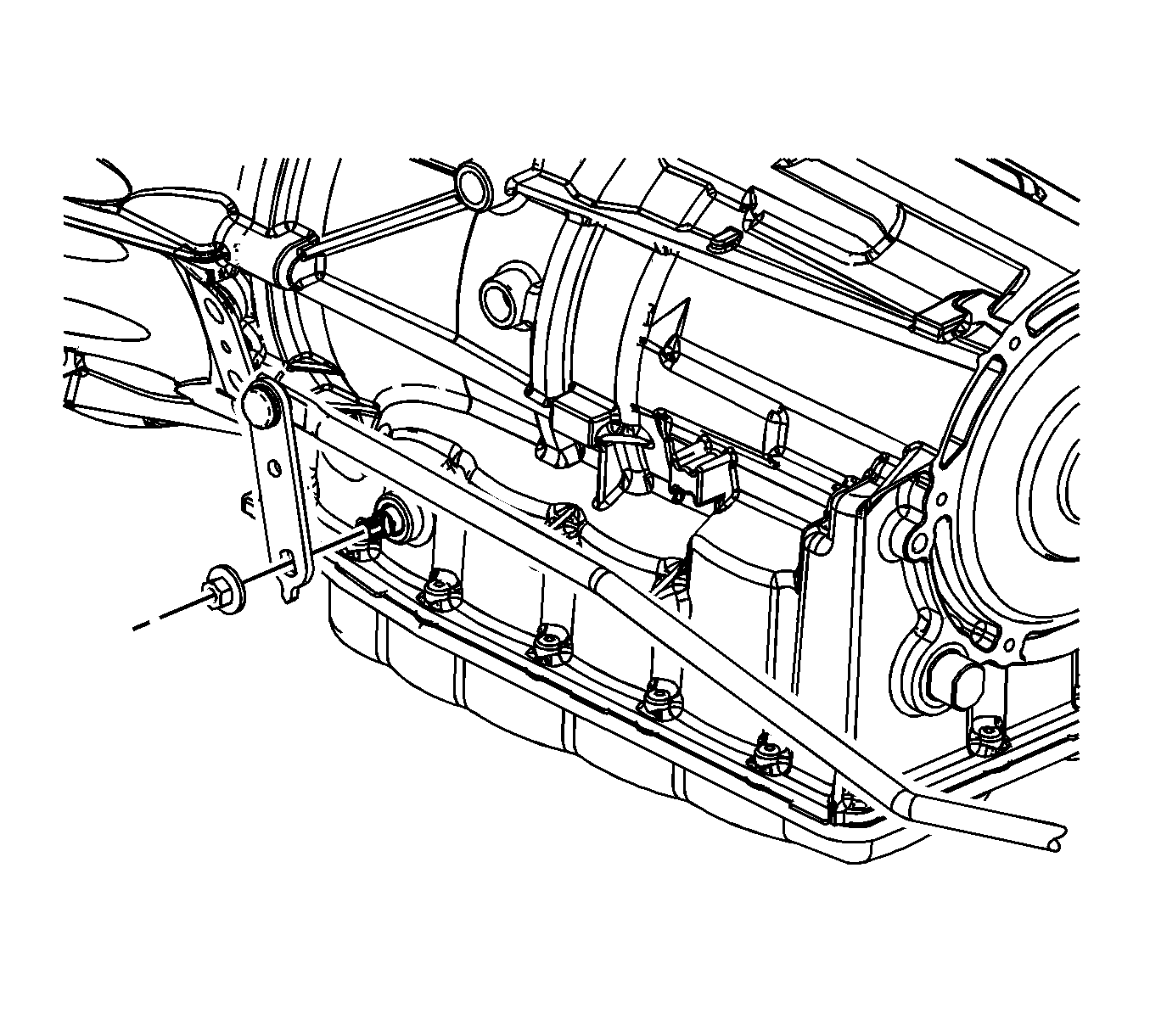

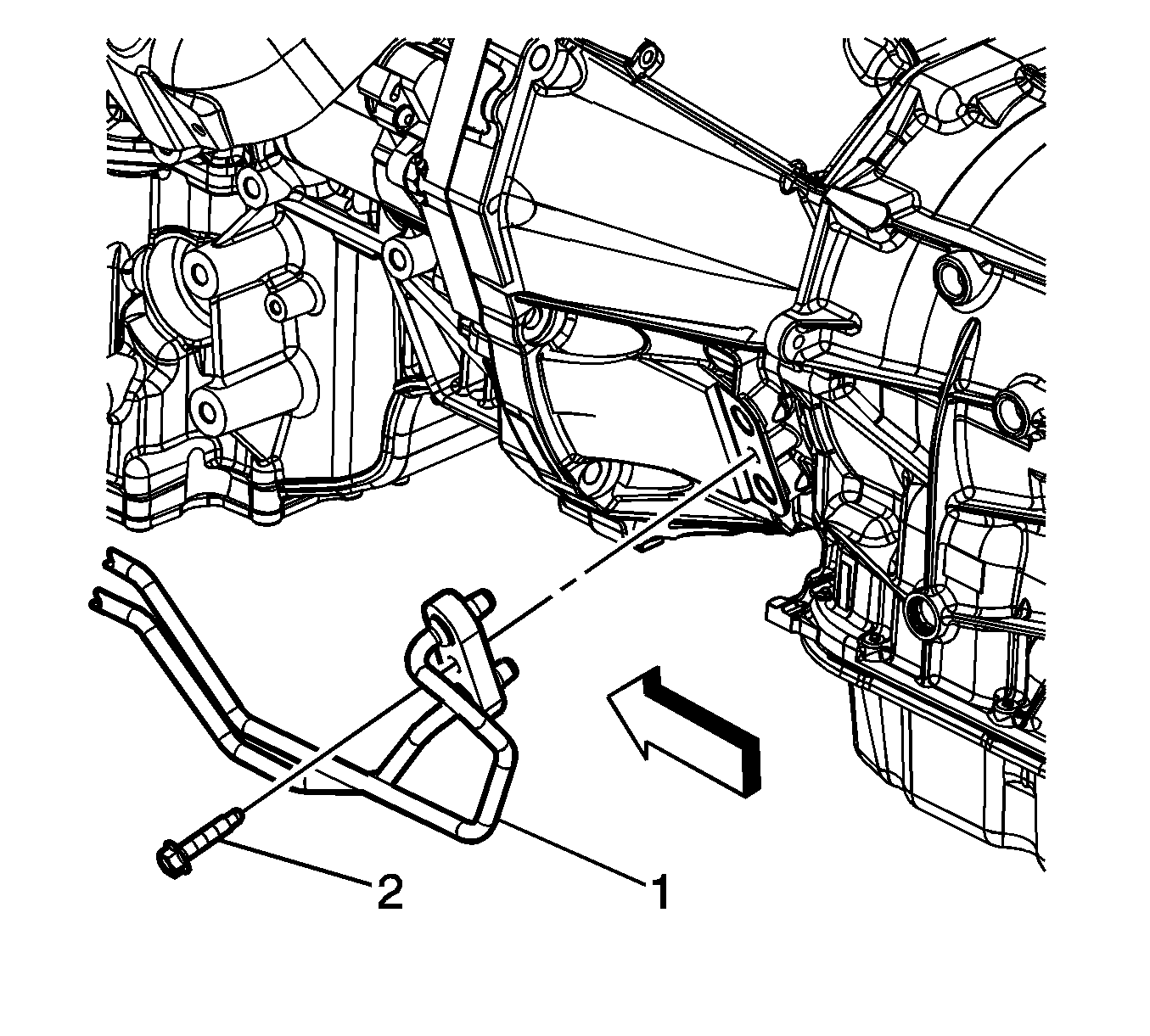
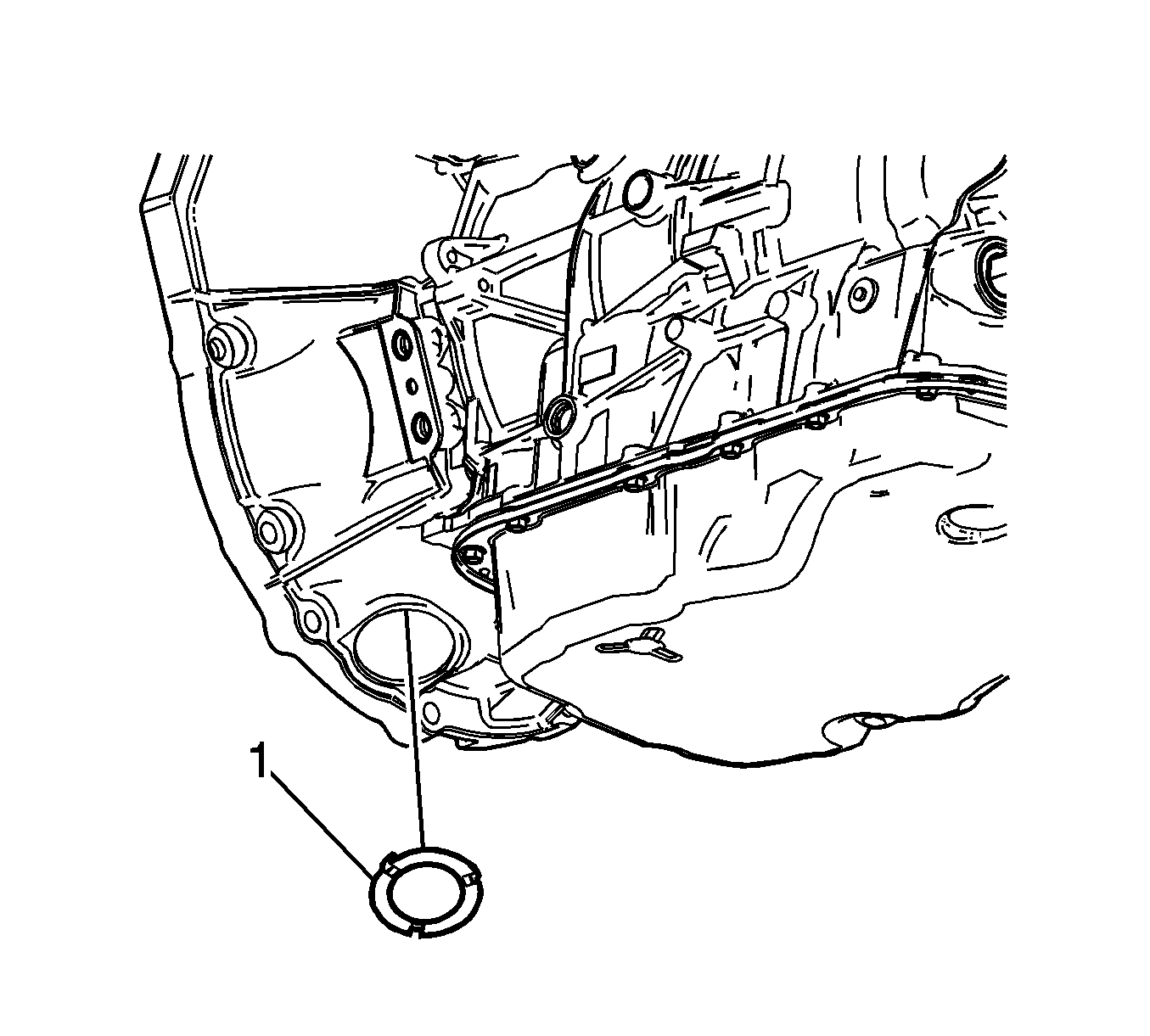
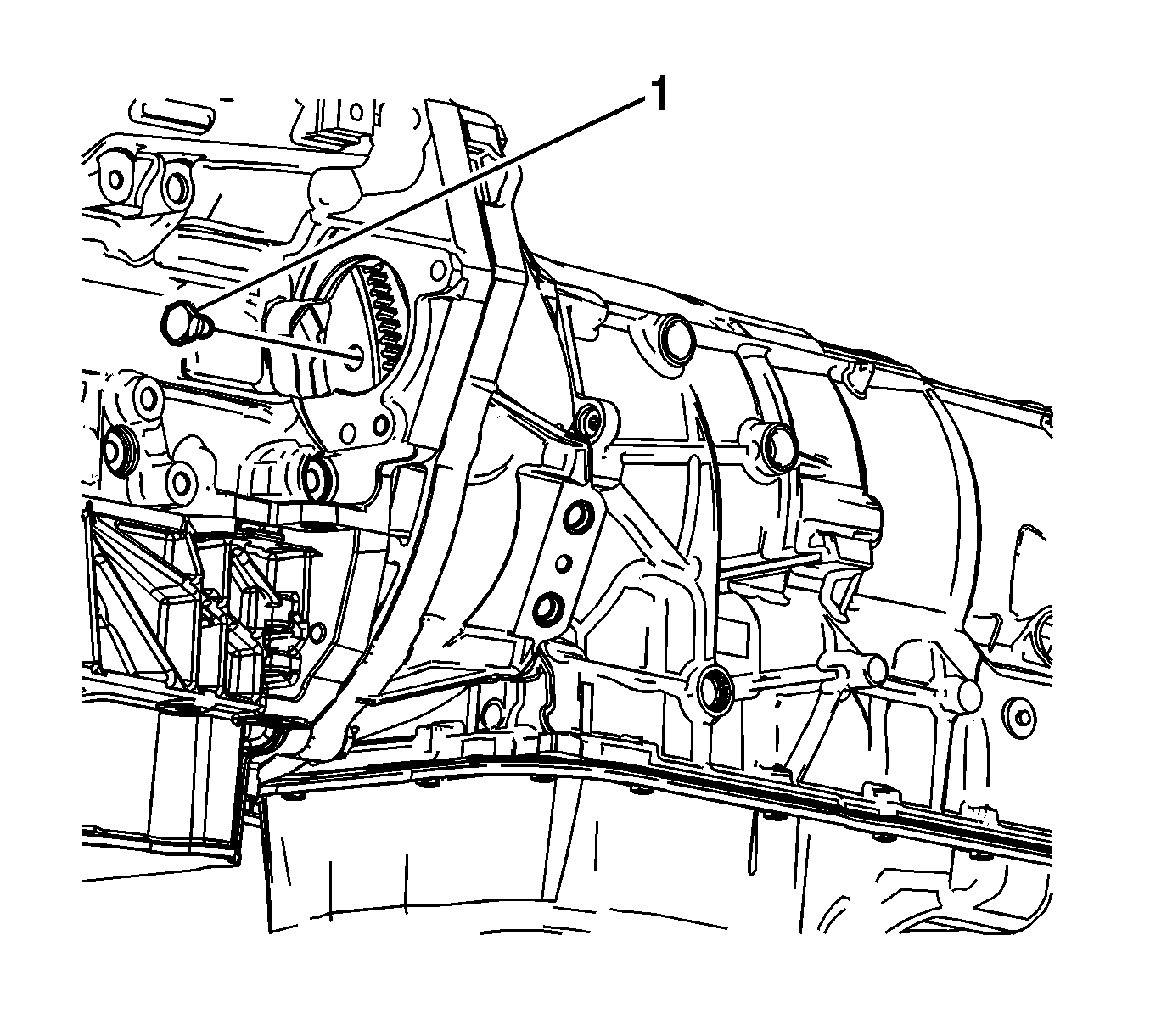
| 17.1. | Rotate the harmonic balancer center bolt clockwise ONLY, in order to align the torque converter bolt with the access hole. |
| 17.2. | Remove and discard the torque converter bolt. |
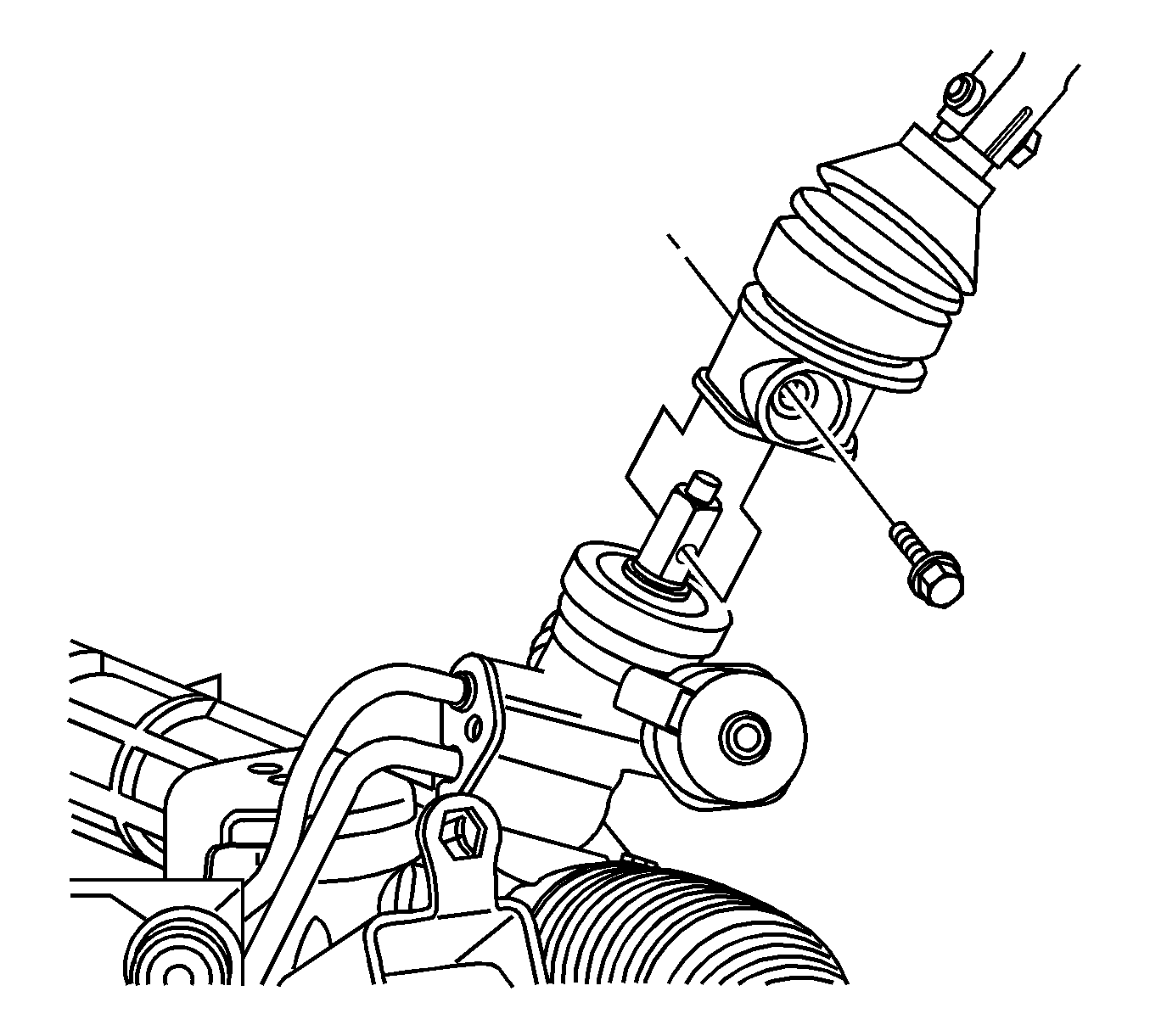
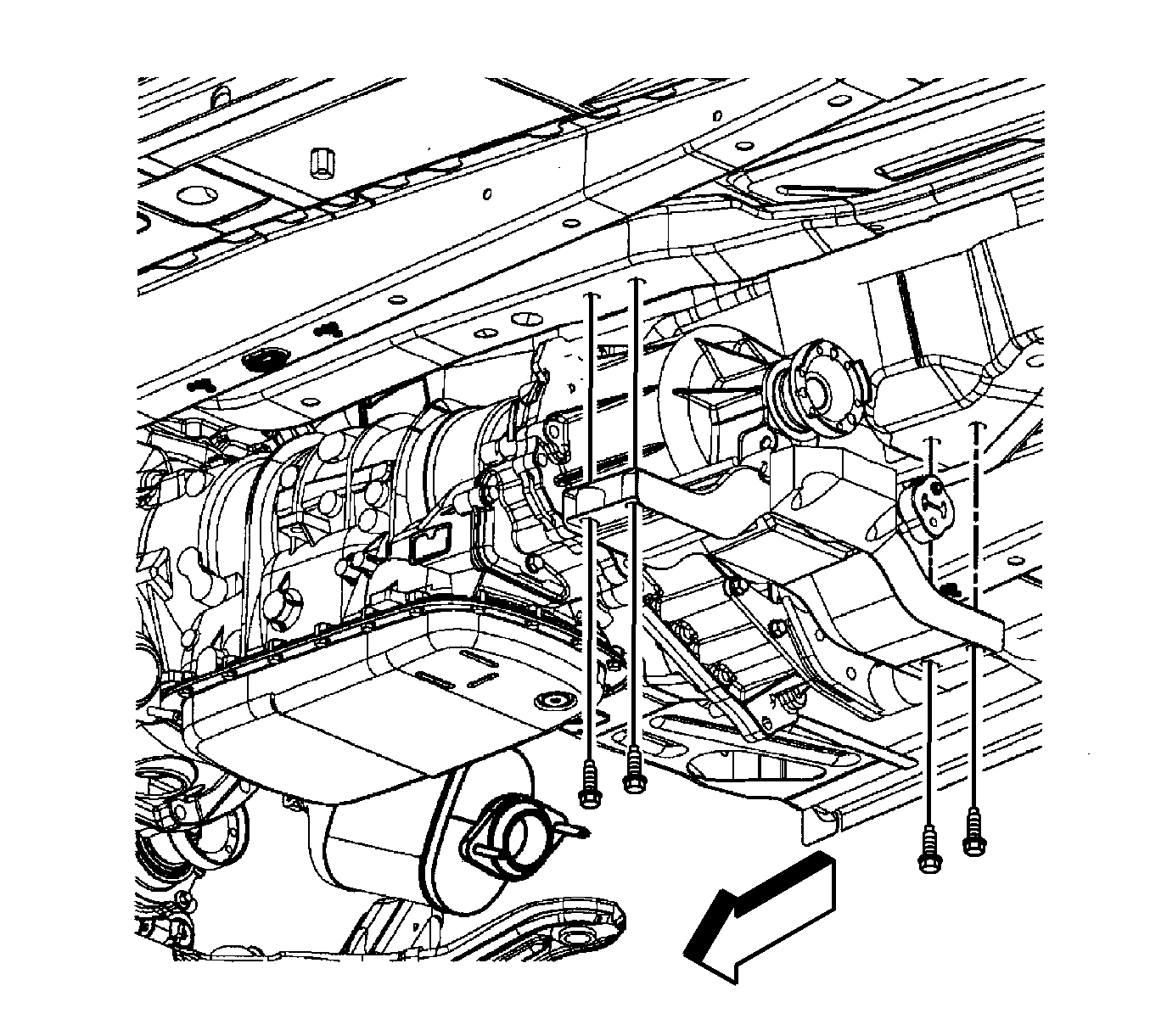

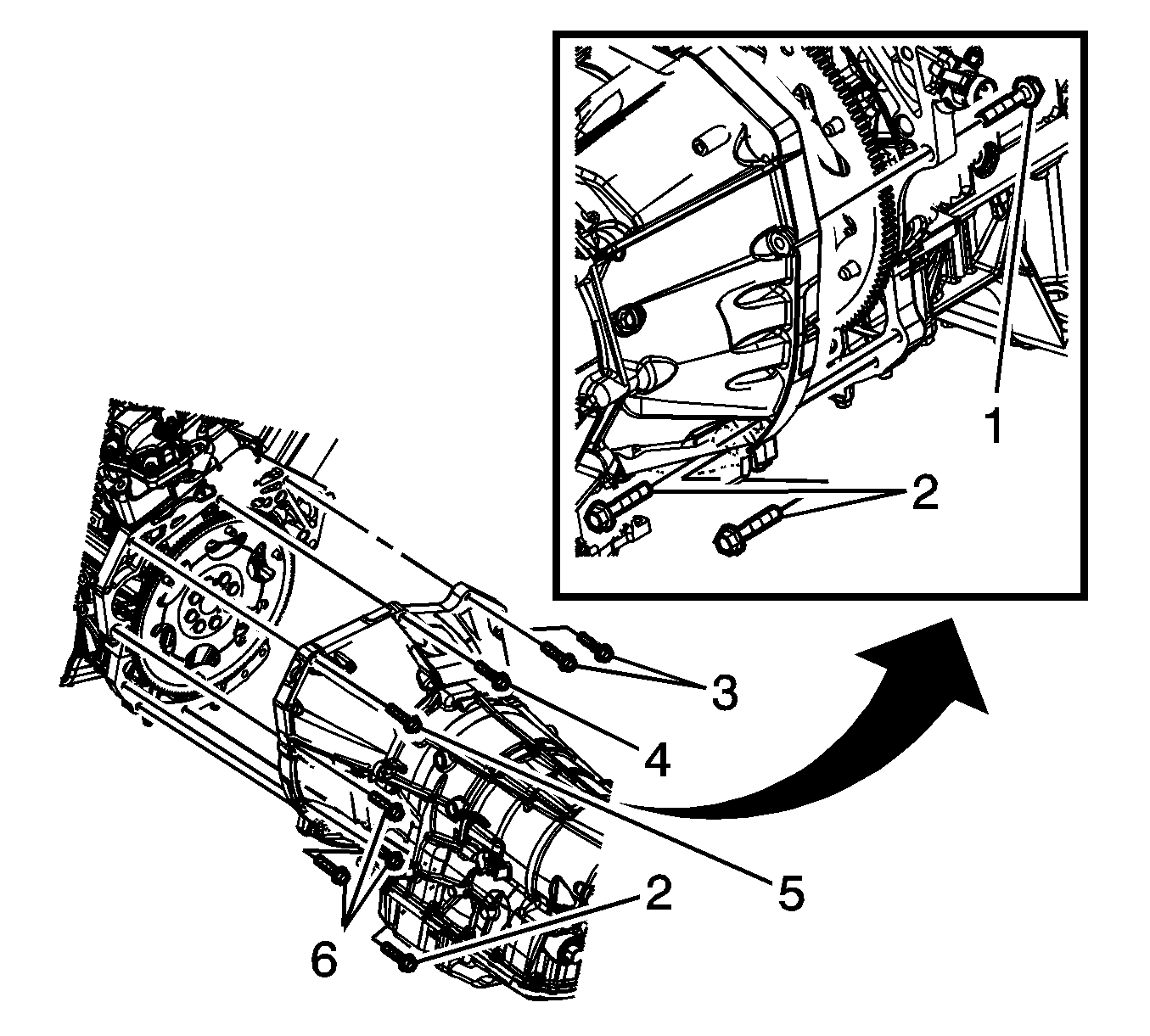
Note: Ensure clearance is maintained between the transmission and the following:
• The wiring harness • The vent tube • The cooler pipes
Installation Procedure
- Using the transmission jack, carefully raise the transmission to the engine.
- Align the transmission with the engine dowels.
- Install the transmission mounting bolts and tighten to 50 N·m (37 lb ft).
- Install the transfer case. Refer to Transfer Case Assembly Replacement.
- Remove the support stand from under the engine oil pan.
- Using the transmission jack. Lower the engine and transmission assembly only enough to gain access to the vent hose tube.
- Install the vent hose (2) to the vent tube.
- Position the engine wiring harness to the original location.
- Raise the transmission to the installed position.
- Install the bolts at the rear of the front frame and properly torque all frame bolts. Refer to Front Frame Replacement for proper frame bolt tightening information.
- Install the transmission mount assembly. Refer to Transmission Mount Replacement.
- Remove the transmission jack.
- Connect the intermediate shaft to the power steering gear. Refer to Steering Gear Replacement.
- Align the torque converter to flexplate/flywheel orientation marks made during the removal procedure.
- Complete the following steps for all torque converter bolts (1):
- Install the transmission close out plug (1).
- Install the starter motor. Refer to Starter Motor Replacement.
- Place NEW O-rings over the transmission fluid cooler pipes.
- Install the transmission fluid cooler pipes (1) to the transmission. Refer to Transmission Fluid Cooler Hose/Pipe Replacement.
- Install the transmission vent hose to the retaining clips (6) on the transmission mount assembly.
- Install the wiring harness retainers (4) to the transmission.
- Connect the transmission wiring harness connector (5) to the transmission by rotating the locking latch clockwise.
- Install the oxygen sensor wiring harness retainer to the transmission.
- Install the shift linkage to the transmission.
- Install the transmission manual shift shaft nut and tighten to 15 N·m (11 lb ft).
- Install the front and rear propeller shafts. Refer to Front Propeller Shaft Replacement and Rear Propeller Shaft Replacement.
- Install the catalytic converters. Refer to Catalytic Converter Replacement - Left Side and Catalytic Converter Replacement - Right Side.
- Install the exhaust system. Refer to Exhaust System Replacement.
- Lower the vehicle.
- Install the thermostat housing. Refer to Engine Coolant Thermostat Housing Replacement.
- Check the transmission fluid level and fill if necessary. Refer to Transmission Fluid Check.
- Adjust the shift control linkage. Refer to Shift Control Linkage Adjustment.
Note: Ensure clearance is maintained between the transmission and the following:
• The wiring harness • The vent tube • The cooler pipes
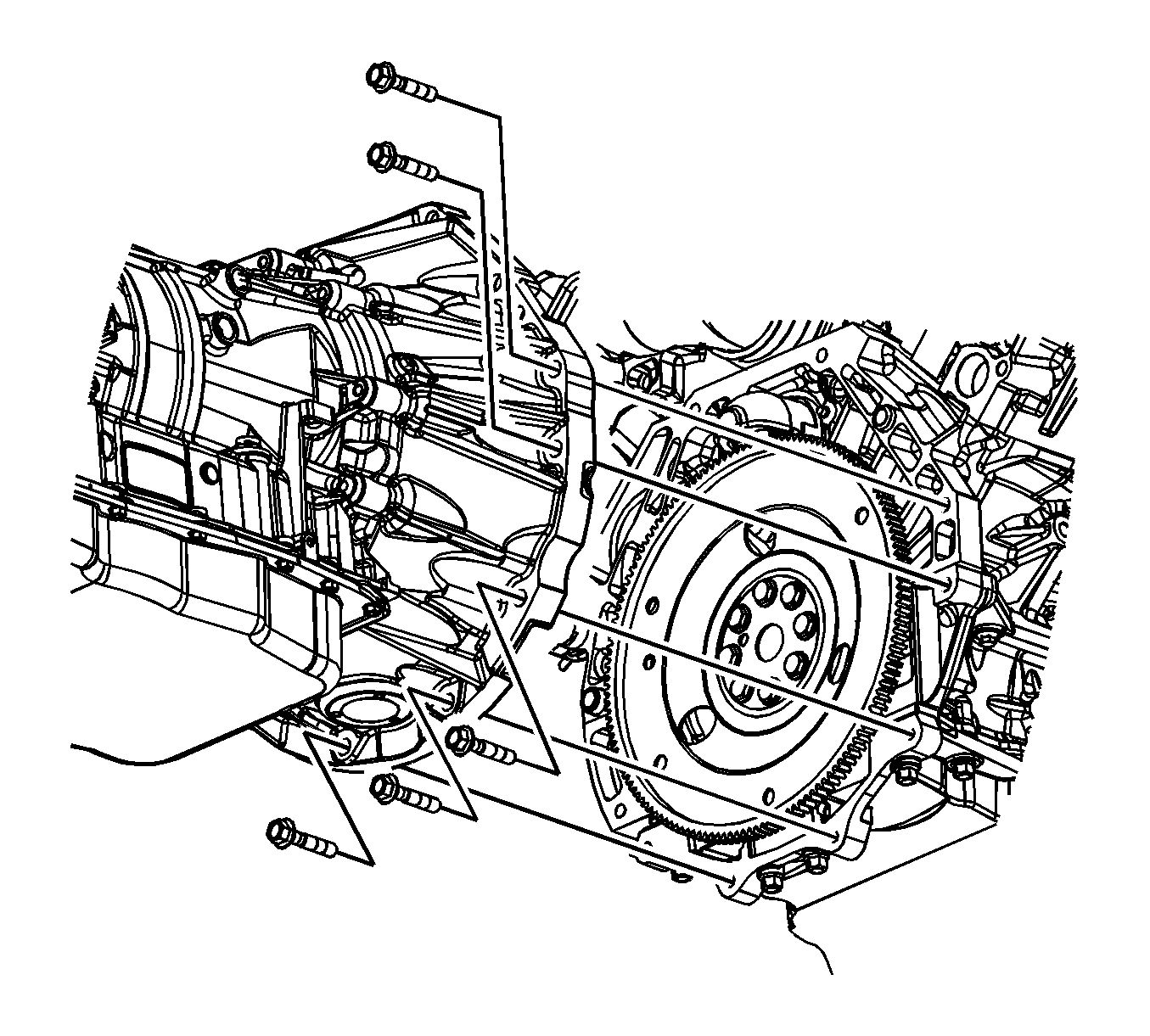
Caution: Refer to Fastener Caution in the Preface section.




Note: Torque converter bolts are self locking and must be replaced with NEW torque converter bolts every time the bolts are removed.
| 15.1. | Rotate the harmonic balancer center bolt clockwise ONLY, in order to align the torque converter bolt holes in the flexplate/flywheel with the access hole in the engine block. |
| 15.2. | To aid in alignment of the torque converter to the flexplate/flywheel. Install all NEW torque converter bolts (1) before fully tightening to 63 N·m (46 lb ft). |




Transmission Final Test and Inspection
Complete the following procedure after the transmission is installed in the vehicle:
- With the ignition OFF or disconnected, crank the engine several times. Listen for any unusual noises or evidence that any parts are binding.
- Start the engine and listen for abnormal conditions.
- While the engine continues to idle, raise and support the vehicle. Refer to Lifting and Jacking the Vehicle.
- Inspect for fluid leaks while the engine is idling.
- Perform a final inspection for the proper fluid level.
- Lower the vehicle.
- Calibrate the transmission control module (TCM). Refer to Control Module References.
- Reset the TAP values. Refer to Transmission Adaptive Functions.
- Road test the vehicle.
Note: It is recommended that transmission adaptive pressure (TAP) information be reset.
Resetting the TAP values using a scan tool will erase all learned values in all cells. As a result, the ECM, PCM or TCM will need to relearn TAP values. Transmission performance may be affected as new TAP values are learned.Transmission Replacement Rear Wheel Drive
Note: NEW cooler pipe O-rings and torque converter bolts will be required each time the transmission is removed and installed.
Removal Procedure
- Remove the thermostat housing. Refer to Engine Coolant Thermostat Housing Replacement.
- Remove the exhaust system. Refer to Exhaust System Replacement.
- Remove the catalytic converters. Refer to Catalytic Converter Replacement - Left Side and Catalytic Converter Replacement - Right Side.
- Remove the propeller shaft. Refer to Rear Propeller Shaft Replacement.
- Disconnect the shift linkage from the transmission.
- Remove the transmission vent hose from the retaining clips (6) on the transmission support.
- Disconnect the transmission wiring harness connector (4) from the transmission by releasing the locking mechanism and rotating the latch counterclockwise.
- Remove the wiring harness retainers (1) from the transmission.
- Remove the oxygen sensor wiring harness connector (2) from the transmission.
- Place an oil drain pan under the transmission fluid cooler pipes.
- Remove the transmission fluid cooler pipes (1) from the transmission, and position aside. Refer to Transmission Fluid Cooler Hose/Pipe Replacement.
- Remove and discard the O-rings. Do NOT reuse the O-rings.
- Plug the open outlet ports to prevent fluid loss and contamination.
- Remove the transmission close out plug (1).
- Mark the torque converter to flexplate/flywheel orientation to ensure proper realignment.
- Remove the starter motor. Refer to Starter Motor Replacement.
- Repeat the following steps for all torque converter bolts (1):
- Support the transmission with a suitable transmission jack.
- Remove the transmission support. Refer to Transmission Support Replacement.
- Lower the transmission.
- Disconnect the transmission vent hose (4) from the transmission vent pipe (1).
- Remove the wiring harness retainers (2) from the transmission.
- Position the transmission wiring harness (1) and vent tube out of the way.
- Remove the transmission mounting bolts (1-6).
- Pull the transmission free from the engine dowels.
- Carefully lower the transmission from the vehicle.
- Flush the transmission oil cooler if necessary. Refer to Transmission Fluid Cooler Flushing and Flow Test.

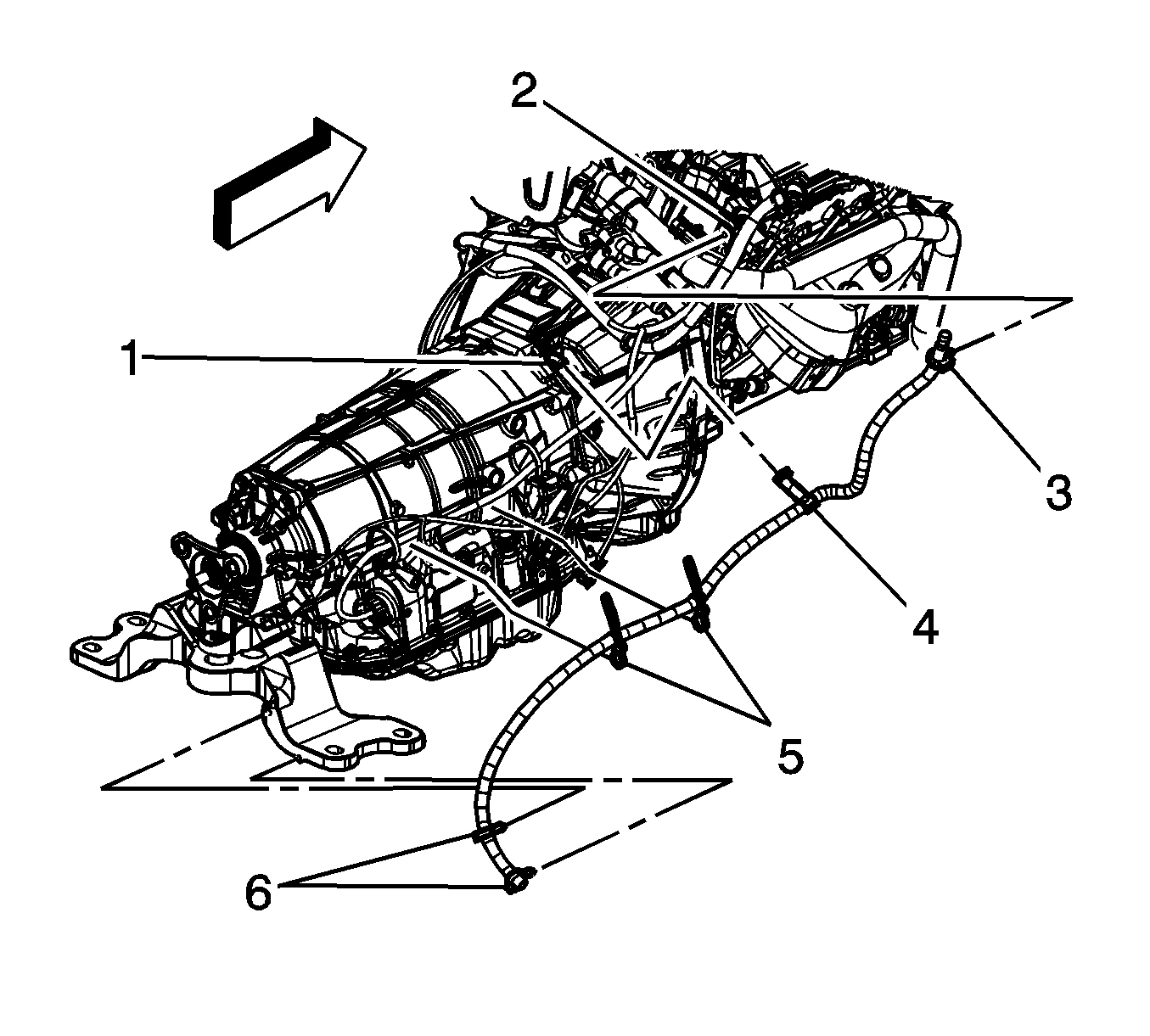




| 17.1. | Rotate the harmonic balancer center bolt clockwise ONLY, in order to align the torque converter bolt with the access hole. |
| 17.2. | Remove and discard the torque converter bolt. |

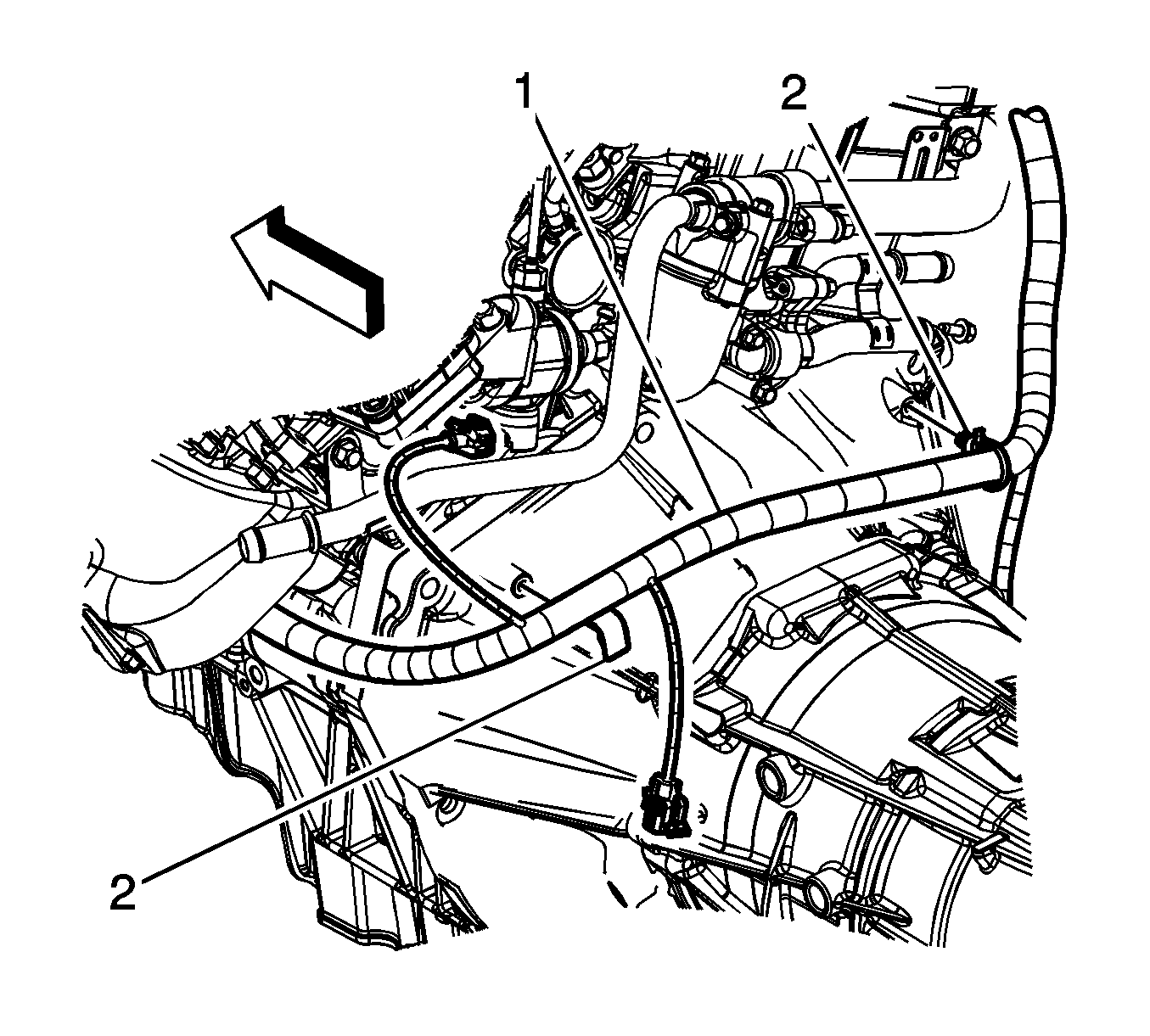

Note: Ensure clearance is maintained between the transmission and the following:
• The wiring harness • The vent tube • The cooler pipes
Installation Procedure
- Using the transmission jack, carefully raise the transmission to the engine.
- Align the transmission with the engine dowels.
- Install the transmission mounting bolts and tighten to 50 N·m (37 lb ft).
- Position the engine wiring harness (1) to the original location.
- Install the wiring harness retainers (2) to the transmission.
- Connect the transmission vent hose (4) to the transmission vent pipe (1).
- Raise the transmission to the installed position.
- Install the transmission support. Refer to Transmission Support Replacement.
- Remove the jack from under the transmission.
- Align the torque converter to flexplate/flywheel orientation marks made during the removal procedure.
- Complete the following steps for all torque converter bolts (1):
- Remove the starter motor. Refer to Starter Motor Replacement.
- Install the transmission close out plug (1).
- Place NEW O-rings over the transmission fluid cooler pipes.
- Install the transmission fluid cooler pipes (1) to the transmission. Refer to Transmission Fluid Cooler Hose/Pipe Replacement.
- Install the oxygen sensor wiring harness connector (2) from the transmission.
- Install the wiring harness retainers (1) to the transmission.
- Connect the transmission wiring harness connector (5) to the transmission by rotating the locking latch clockwise.
- Install the transmission vent hose to the retaining clips (6) on the transmission support.
- Install the shift linkage to the transmission.
- Install the transmission manual shift shaft nut and tighten to 15 N·m (11 lb ft).
- Install the propeller shaft. Refer to Rear Propeller Shaft Replacement.
- Install the catalytic converters. Refer to Catalytic Converter Replacement - Left Side and Catalytic Converter Replacement - Right Side.
- Install the exhaust system. Refer to Exhaust System Replacement.
- Lower the vehicle.
- Install the thermostat housing. Refer to Engine Coolant Thermostat Housing Replacement.
- Check the transmission fluid level and fill if necessary. Refer to Transmission Fluid Check.
- Adjust the shift control linkage. Refer to Shift Control Linkage Adjustment.
Note: Ensure clearance is maintained between the transmission and the following:
• The wiring harness • The vent tube • The cooler pipes

Caution: Refer to Fastener Caution in the Preface section.



Note: Torque converter bolts are self locking and must be replaced with NEW torque converter bolts every time the bolts are removed.
| 11.1. | Rotate the harmonic balancer center bolt clockwise ONLY, in order to align the torque converter bolt holes in the flexplate/flywheel with the access hole in the engine block. |
| 11.2. | To aid in alignment of the torque converter to the flexplate/flywheel. Install all NEW torque converter bolts before fully tightening to 63 N·m (46 lb ft). |





Transmission Final Test and Inspection
Complete the following procedure after the transmission is installed in the vehicle:
- With the ignition OFF or disconnected, crank the engine several times. Listen for any unusual noises or evidence that any parts are binding.
- Start the engine and listen for abnormal conditions.
- While the engine continues to idle, raise and support the vehicle. Refer to Lifting and Jacking the Vehicle.
- Inspect for fluid leaks while the engine is idling.
- Perform a final inspection for the proper fluid level.
- Lower the vehicle.
- Calibrate the transmission control module (TCM). Refer to Control Module References.
- Reset the TAP values. Refer to Transmission Adaptive Functions.
- Road test the vehicle.
Note: It is recommended that transmission adaptive pressure (TAP) information be reset.
Resetting the TAP values using a scan tool will erase all learned values in all cells. As a result, The ECM, PCM or TCM will need to relearn TAP values. Transmission performance may be affected as new TAP values are learned.